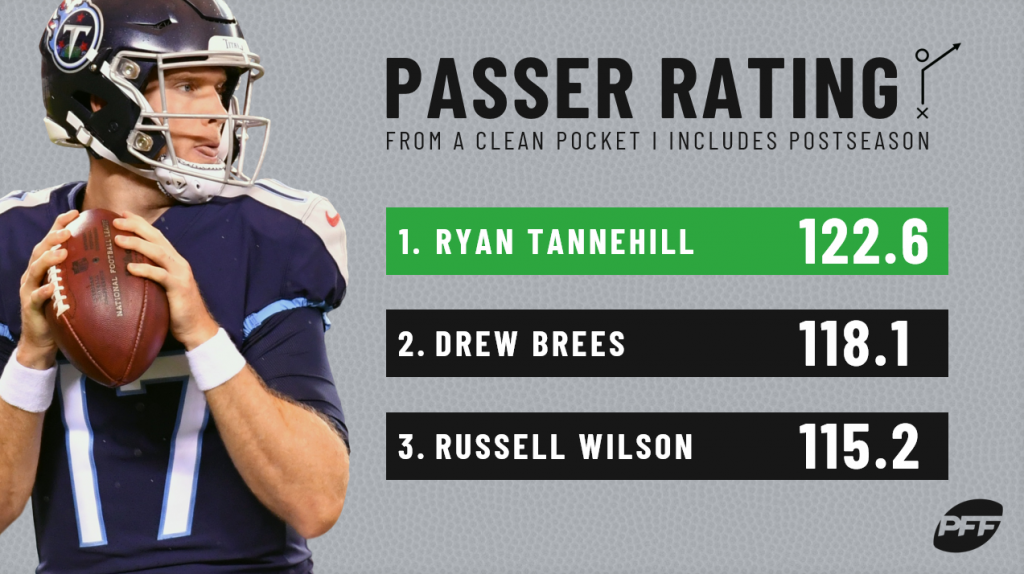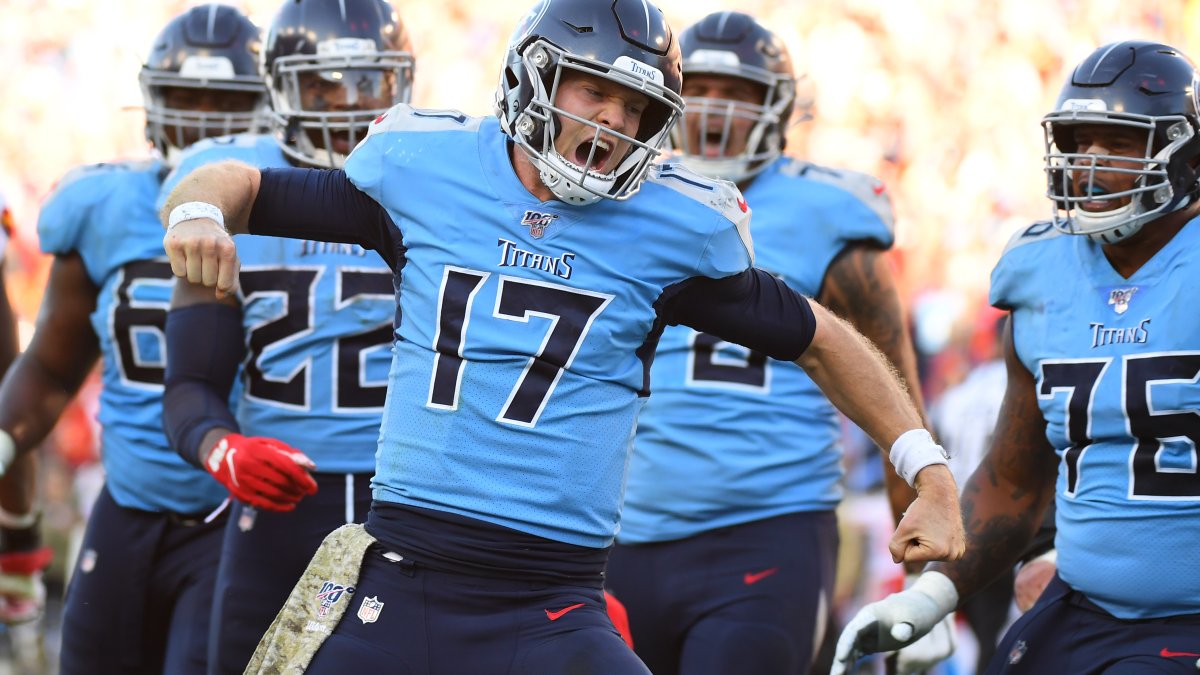PFF’s in-depth charting and advanced stats look beyond the box score to identify key metrics otherwise overlooked across all positions in the NFL. This “Signature Stat Spotlight” series will walk readers through the varying advanced stats and metrics we track for every player at every position in every game.
Evaluating the most important, most valuable position in football isn’t easy. Quarterbacks can’t be defined by any one number, not a box-score stat or advanced statistic. As such, quantifiably measuring the success of the NFL’s signal-callers requires multiple numbers, PFF’s grading system and advanced stats – both included and not included in Premium Stats 2.0.
[Editor’s Note: To dive into PFF’s grading system and Premium Stats 2.0, subscribe to PFF’s ELITE – Monthly or ELITE – Annual subscription.]
Some of PFF’s well-known advanced stats used to measure quarterback success include adjusted completion percentage, passer rating under pressure, passer rating when kept clean and time to throw. We also chart quarterback success on deep passes – passes thrown 20-plus yards through the air – and play-action dropbacks.
Adjusted completion percentage takes box-score completion percentage to the next level. The formula: ((Completions + Drops) / (Attempts – Throw Aways – Spikes – Batted Passes – Hit As Thrown)). Removing throwaways, spikes, batted passes and passes released while being hit creates a completion percentage that's more indicative of quarterback accuracy and success.
Outside of Premium Stats 2.0, PFF’s team of analysts, including former NFL signal-caller Bruce Gradkowski, chart ball location for quarterbacks to better evaluate quarterback accuracy across the NFL and FBS. PFF also makes a note of what we call big-time throws and turnover-worthy plays, the former being any attempt that receives a raw grade of +1.0 or higher in our system and the latter representing any dropback that receives a raw grade of -1.0 or lower – this includes dropped interceptions.
[Editor’s Note: PFF's raw grading system, which runs on a -2.0 to +2.0 scale, is further explained in this article.]
PFF’s quarterback charting continues to grow, as well. Our analysts have now started to chart quarterback decision (i.e., first read, checkdown), targeted route, incompletion type (i.e., dropped pass, pass breakup) and much more as we continue to develop our skills, add to our staff and learn more about the stable, valuable elements of quarterback play.
To access the advanced stats and analysis that are products of PFF's grading system (e.g. big-time throws, turnover-worthy plays) and/or ball location charting (e.g. accuracy percentage, uncatchable passes thrown), subscribe to PFF's EDGE or ELITE subscription and download the 2020 QB Annual.
Signature Stat Spotlight Series:
QB | RB | WR | TE | OL | DL | LB | CB | S
Adjusted Completion Percentage
New Orleans Saints veteran signal-caller Drew Brees led all NFL quarterbacks with 300 or more total dropbacks in 2019 in PFF’s adjusted completion percentage at 83.2%. He’s now finished first in adjusted completion percentage in each of the past three NFL seasons and hasn’t ranked outside the top-10 in the metric since 2008.
| Year | Drew Brees' Adj. Completion % | Rank Among Qualifiers |
| 2019 | 83.2% | 1 |
| 2018 | 81.5% | 1 |
| 2017 | 80.1% | 1 |
| 2016 | 79.8% | 2 |
| 2015 | 77.2% | 6 |
| 2014 | 80.2% | 1 |
| 2013 | 76.2% | 5 |
| 2012 | 76.2% | 6 |
| 2011 | 78.9% | 2 |
| 2010 | 77.7% | 1 |
| 2009 | 79.0% | 2 |
| 2008 | 75.1% | 13 |
| 2007 | 79.2% | 2 |
| 2006 | 77.3% | 2 |
Among the same 30 quarterbacks with 300 or more dropbacks in 2019, Detroit Lions’ Matthew Stafford ranked last in PFF’s adjusted completion percentage (69.4%). Cleveland Browns second-year quarterback Baker Mayfield ranked second-to-last at 69.5%.
Among the 30 NFL quarterbacks with 30 or more deep pass attempts (passes of 20-plus air yards), San Francisco 49ers’ Jimmy Garoppolo ranked first in adjusted completion percentage on such throws at 74.2%. Houston Texans’ Deshaun Watson finished second behind Garoppolo with his 54.1% adjusted completion percentage on deep throws in 2019.
On the opposite end of the list are Kyle Allen, Mason Rudolph and Josh Allen. The three signal-callers all finished with adjusted completion percentages below 31% on deep passes in 2019.
Clean-Pocket/Pressured Passing Performance
Performance from a clean pocket, per PFF’s data scientists Eric Eager and George Chahrouri, has proven stable year over year in the NFL, which includes passer rating and PFF passing grade from a clean pocket. Conversely, play under pressure is extremely volatile year over year but still a valuable metric to study when evaluating single-season performances.
Tennessee Titans quarterback Ryan Tannehill finished his stellar 2019 campaign as the NFL’s leader in clean-pocket passer rating at 122.8. He completed 166-of-224 attempts (74.1%) for 2,209 yards, 17 touchdowns and just four picks when kept clean this past season. Brees and Stafford finished right behind Tannehill at 120.7 and 120.0, respectively.

No quarterback with at least 200 clean dropbacks in 2019 recorded a lower clean-pocket passer rating than Washington Redskins rookie signal-caller Dwayne Haskins at 81.8. He completed just 63.2% of his attempts for 1,089 yards, five touchdowns and five picks when kept clean a year ago. Haskins, Andy Dalton, Mayfield and Kyle Allen were the only four quarterbacks with sub-90.0 clean-pocket passer ratings in 2019.
Tannehill also led all NFL quarterbacks with at least 100 pressured dropbacks in 2019 in passer rating when pressured at 98.4. He completed 35-of-62 passes for 533 yards, five touchdowns and two picks across his 100 pressured dropbacks this past season. Baltimore Ravens second-year quarterback Lamar Jackson finished second behind Tannehill in pressured passer rating at 97.7.
The two bottom-ranked quarterbacks in passer rating under pressure were Rudolph and Tampa Bay Buccaneers’ Jameis Winston at 35.6 and 44.5, respectively. New England Patriots veteran Tom Brady also recorded a surprisingly low passer rating when pressured (51.8) that ranked as the third-worst mark among qualifiers in 2019.
Play-Action Passing Performance
PFF also charts and track play-action passing performance in Premium Stats 2.0. Among the 25 NFL quarterbacks with at least 100 play-action dropbacks in 2019, Tannehill ranked first in play-action passer rating at 143.3. He also ranked first in completion percentage (76.7%) and yards per attempt (13.5) on play-action dropbacks.
Jackson recorded the highest NFL passer rating on non-play-action dropbacks at 109.5, and Mayfield recorded the lowest passer rating on said dropbacks (68.8).
Time-to-Throw Metrics
PFF also charts time to throw one every passing play in the NFL. In addition to ranking the quarterbacks by average time to throw in Premium Stats 2.0, PFF splits passing performance by throws made within 2.5 seconds of the snap and throws made 2.6. seconds or longer after the snap. Dalton and Brees finished the 2019 season tied for the lowest average time to throw among qualifiers at 2.39 seconds. Kirk Cousins’ 2.83-second time-to-throw average was the longest of any NFL quarterback with 300 or more dropbacks in 2019.
Brees’ 114.8 passer rating on throws made within 2.5 seconds of the snap led all qualifying signal-callers this past season. He completed 177-of-220 attempts for 15 touchdowns and two interceptions on said throws. Winston’s 78.4 passer rating on such throws was the lowest in the NFL in 2019.
Tannehill recorded a league-high 125.1 passer rating on throws made 2.6 seconds or longer after the snap, while Miami Dolphins’ Ryan Fitzpatrick recorded the lowest passer rating on such throws at 67.9.
To continue to learn more about PFF’s advanced stats, please stay tuned for the rest of our Signature Stat Spotlight Series. Or, better yet, subscribe to PFF’s ELITE subscription to dive into the numbers yourself throughout the offseason and into next season.
Signature Stat Spotlight Series:



 © 2025 PFF - all rights reserved.
© 2025 PFF - all rights reserved.